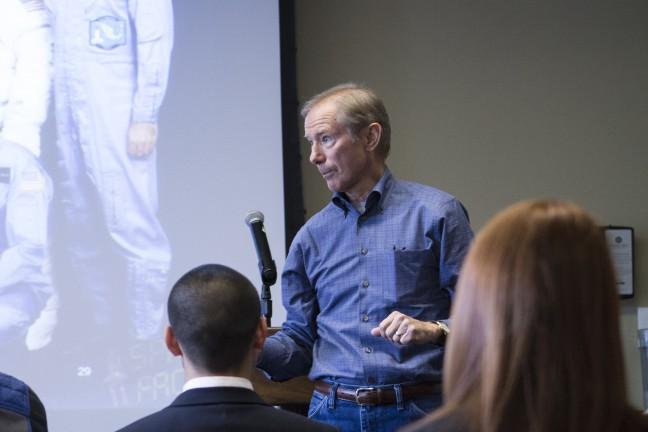Former astronaut Brewster Shaw, who worked for NASA for 27 years and logged 533 hours of space flight, spoke to students at Union South Thursday about what it’s like to be in space.
In an event hosted by Badger Aviators, a student organization that promotes college aviation, Shaw described his experiences in space, where he said he spent a lot of time alone on the flight deck. When he wasn’t working on a particular task, he would look out at the earth because the view was “remarkable.”
“You look out the window because the earth is fabulous to look at from 140 miles up,” Shaw said. “The earth turns underneath your orbit.”
Shaw said he was incredibly fortunate to be able to go up in space and see earth from that vantage point. Thousands apply whenever there is an opening in NASA for astronauts, he said.
After he experienced space, Shaw said he wanted to do whatever he could to get as many other human beings up in space as possible.
“I got to do the only two things that I professionally really wanted to do,” Shaw said. “Fly in space, and see other people fly in space. How lucky is that?”
Though going into space is an amazing experience, Shaw said it comes with risks. Before NASA required them to get new suits, if they were exposed to outer space they would be able to get oxygen, but their blood would boil within minutes.
The new suits provided more protection, but they still didn’t provide enough to the seven astronauts who died during the Columbia Space Shuttle disaster in 2003, Shaw said. There’s never a way to make things 100 percent safe, Shaw said.
“You have to understand the risks you’re getting yourself into,” Shaw said.
During his time as an astronaut and a pilot, Shaw said a plane or space shuttle he was in getting catch fire three different times.
One of the times was in the Columbia Space Shuttle before it was destroyed, another was when a plane caught fire while flying and the last when lightening struck a different plane, Shaw said.
Shaw said in the first plane incident, he and a student ejected themselves from the plane and watched it explode beneath them. With the plane that was struck by lightning, Shaw said he and his colleague decided to try to land because it was in a civilian area.
“We land, and the tower calls up and says hey, you guys are on fire … We both jump over the side and run like hell,” Shaw said. “Fire in an airplane is not a good thing.”
Shaw said when traveling to and from space, there are three distinct times when light flashes. While ascending into space, Shaw said he sees light reflecting around the shuttle as it burns up before going into space.
When descending back into earth’s atmosphere, Shaw said, the light flashes “energetically” and “dynamically” around the shuttle, and would be within reaching distance if not for the protection of the space shuttle.
Flashing also occurs when traveling through the Aurora Borealis because the sky becomes “alive” with a “light show” while traveling through the atmosphere, Shaw said.
For those who doubt whether NASA has sent men to the moon or even into space, Shaw said there’s usually no reasoning with them. But he said he has been in space and has talked to several people who went to the moon. He said traveling to the moon is “a hell of a story” if it isn’t actually true.
In addition to the moon, Shaw also said he hopes NASA will make it to Mars, but this brings challenges. He said in order for NASA to send men to Mars, there needs to be technological advances and international support.
“I do think we’ll eventually do it, and I hope I’m still alive when that happens,” Shaw said.


